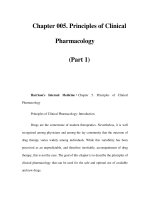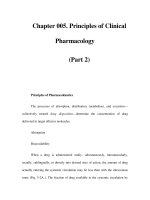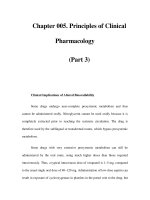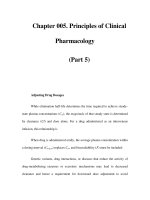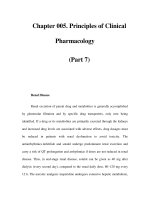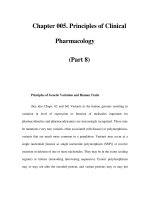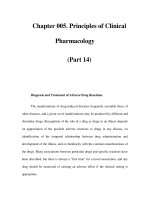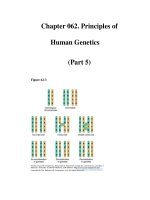Chapter 081. Principles of Cancer Treatment (Part 16) pot
Bạn đang xem bản rút gọn của tài liệu. Xem và tải ngay bản đầy đủ của tài liệu tại đây (13.82 KB, 5 trang )
Chapter 081. Principles of
Cancer Treatment
(Part 16)
The taxanes include paclitaxel and docetaxel. These agents differ from the
vinca alkaloids in that the taxanes stabilize microtubules against depolymerization.
The "stabilized" microtubules function abnormally and are not able to undergo the
normal dynamic changes of microtubule structure and function necessary for cell
cycle completion. Taxanes are among the most broadly active antineoplastic
agents for use in solid tumors, with evidence of activity in ovarian cancer, breast
cancer, Kaposi's sarcoma, and lung tumors. They are administered intravenously,
and paclitaxel requires use of a Cremophor-containing vehicle that can cause
hypersensitivity reactions. Premedication with dexamethasone (20 mg orally or
intravenously 12 and 6 h before treatment) and diphenhydramine (50 mg) and
cimetidine (300 mg), both 30 min before treatment, decreases but does not
eliminate the risk of hypersensitivity reactions to the paclitaxel vehicle. Docetaxel
uses a polysorbate 80 formulation, which can cause fluid retention in addition to
hypersensitivity reactions, and dexamethasone premedication with or without
antihistamines is frequently used. A protein-bound formulation of paclitaxel
(called nab-paclitaxel) has at least equivalent antineoplastic activity and decreased
risk of hypersensitivity reactions. Paclitaxel may also cause hypersensitivity
reactions, myelosuppression, neurotoxicity in the form of glove-and-stocking
numbness, and paresthesia. Cardiac rhythm disturbances were observed in phase I
and II trials, most commonly asymptomatic bradycardia but also, much more
rarely, varying degrees of heart block. These have not emerged as clinically
significant in the majority of patients. Docetaxel causes comparable degrees of
myelosuppression and neuropathy. Hypersensitivity reactions, including
bronchospasm, dyspnea, and hypotension, are less frequent but occur to some
degree in up to 25% of patients. Fluid retention appears to result from a vascular
leak syndrome that can aggravate preexisting effusions. Rash can complicate
docetaxel administration, appearing prominently as a pruritic maculopapular rash
affecting the forearms, but it has also been associated with fingernail ridging,
breakdown, and skin discoloration. Stomatitis appears to be somewhat more
frequent than with paclitaxel.
Estramustine was originally synthesized as a mustard derivative that might
be useful in neoplasms that possessed estrogen receptors. However, no evidence of
interaction with DNA was observed. Surprisingly, the drug caused metaphase
arrest, and subsequent study revealed that it binds to microtubule-associated
proteins, resulting in abnormal microtubule function. Estramustine binds to
estramustine-binding proteins (EMBPs), which are notably present in prostate
tumor tissue. The drug is used as an oral formulation in patients with prostate
cancer. Gastrointestinal and cardiovascular adverse effects related to the estrogen
moiety occur in up to 10% of patients, including worsened heart failure and
thromboembolic phenomena. Gynecomastia and nipple tenderness can also occur.
Hormonal Agents
The family of steroid hormone receptor–related molecules has emerged as
prominent targets for small molecules useful in cancer treatment. When bound to
their cognate ligands, these receptors can alter gene transcription and, in certain
tissues, induce apoptosis. The pharmacologic effect is a mirror or parody of the
normal effects of the agent acting in nontransformed tissue, although the effects on
tumors are mediated by indirect effects in some cases.
Glucocorticoids are generally given in "pulsed" high doses in leukemias
and lymphomas, where they induce apoptosis in tumor cells. Cushing's syndrome
or inadvertent adrenal suppression on withdrawal from high-dose glucocorticoids
can be significant complications, along with infections common in
immunosuppressed patients, in particular Pneumocystis pneumonia, which
classically appears a few days after completing a course of high-dose
glucocorticoids.
Tamoxifen is a partial estrogen receptor antagonist; it has a tenfold greater
antitumor activity in breast cancer patients whose tumors express estrogen
receptors than in those who have low or no levels of expression. Side effects
include a somewhat increased risk of estrogen-related cardiovascular
complications, such as thromboembolic phenomena, and a small increased
incidence of endometrial carcinoma, which appears after chronic use (usually >5
years). Progestational agents—including medroxyprogesterone acetate, androgens
including fluoxymesterone (Halotestin), and, paradoxically, estrogens—have
approximately the same degree of activity in primary hormonal treatment of breast
cancers that have elevated expression of estrogen receptor protein. Estrogen is not
used often owing to prominent cardiovascular and uterotropic activity.
Aromatase refers to a family of enzymes that catalyze the formation of
estrogen in various tissues, including the ovary and peripheral adipose tissue and
some tumor cells. Aromatase inhibitors are of two types, the irreversible steroid
analogs such as exemestane and the reversible inhibitors such as anastrozole or
letrozole. Anastrozole is superior to tamoxifen in the adjuvant treatment of breast
cancer in postmenopausal patients with estrogen receptor–positive tumors.
Letrozole treatment affords benefit following tamoxifen treatment. Adverse effects
of aromatase inhibitors may include an increased risk of osteoporosis.
